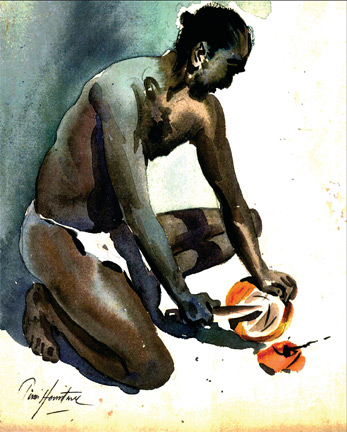Male figure in wash technique
by Tissa Hewavitarane
Almost all artists have an eye for a beautiful body, male figure as
well as female figure. But not many beginners have the opportunity, or
perhaps the confidence, to attend a life drawing class to learn the
skills. If this applies to you don't worry. There are other ways of
learning how to draw and paint a human figure.
You might not have a spouse, relative or friend willing to shed their
threads and life drawing classes may be out of reach. However,
photographs can provide an alternative source of subjects to work from.
I know most painting books sternly and piously advise against using
photos at all, and some of the purists among us regard the camera as a
form of cheating. But let us not be hypocritical about this.
 You and I know that thousands of painters all over the world work out
photographs anyway, so we might as well learn to use them creatively and
responsibly. What has given the process a bad name are the amateurs who
copy photographs slavishly and mindlesly and in every detail. You and I know that thousands of painters all over the world work out
photographs anyway, so we might as well learn to use them creatively and
responsibly. What has given the process a bad name are the amateurs who
copy photographs slavishly and mindlesly and in every detail.
A few other tips are painting courses and art tutors. Dozen of books
are on the market written by top watercolour painters. Each has points
that are extremely helpful, because each artist tries to show the best
way to get exciting results.
The figure is one of the greatest challenges that a watercolourist
can take on, not only because of the subject itself, but also what can
be done with the watercolour techniques. With other pictorial themes a
watercolour painting can have some limitation.
However, with figures exactly the opposite occurs. The subject needs
a lot of rigour, starting of course with the initial drawing.
It is important to bear in mind that the outline of the drawing is
the base of the colour. Therefore, when doing the drawing it is
necessary to keep the painting process in mind. The figure must be
planned in detail, but a part from the possibility that these geometric
shapes offer it can be constructed from well studied internal structure.
As we have seen all the elements of nature can be synthesised from
others which are simple. You will see, with a good drawing the
proportions and the fundamental anatomical forms can be perfectly shown.
The initial sketch has the task of laying out the most elementary and
simple outlines before filling them with colour. Before starting to
paint, the drawing has to be perfectly finished.
Once you have learned to construct the figure correctly, the next
step is to give shape to the drawing. This is done with colour and
various light effects that are carried out on the paper. Just like other
themes that can be painted with watercolour, a certain amount of light
is projected on to every figure.
This means that some areas can be represented with light and other
shadows. The light areas always have to be those reserved by the darker
tones, it is precisely this effect that produces the volume.
The parts of the figure most exposed to light will have to be
outlined by the shadow which will always adapt to the anatomy. Once the
figure is defined and the drawing is refined the painting of the volume
is started by placing the shadows and the light areas. When starting out
with the volume proceed with caution from it must be suggested by the
points of maximum luminosity.
The synthesis should be the principal recourse of the watercolourist.
Synthesis means the process by which the representation of subjects is
reduced to the most basic elements.
In general, when painting without experience there is a tendency to
fall into the trap of cluttering with excessive details.
As experience is acquired unnecessary factors are eliminated. To
paint well you have to know what is important and what is superfluous.
By being very economical with techniques, it is possible to point the
figures of fairly advanced technical level, despite doing away with
unimportant details.
Wash drawing
There are many techniques that normally can be to paint a human
figure. Besides being able to represent the colour, it is important to
master and study the human anatomy, to draw and paint correctly.
We have looked at basic watercolour techniques of wash in previous
exercises wet-into-wet, dry brush and calligraphy.
They all have their strengths and weaknesses. Wash, for example, is
the most positive way of indicating shapes. Its strength lies in its
simplicity despite the fact that wash is executed with watercolour it is
really a painting technique.
Observe carefully in my own painting man cutting a king coconut how
closely wash is linked to the drawing. The brush is used to apply lines
in the same way one forms lines with a pen. A wash allows the painting
to apply different tones of the same colour, according to the amount of
water that is added to the paint on the palette.
The first layer will be the base for all the texture to produce skin
tones. The base colour will allow all the later applications to act like
a filter modifying the original colours according to the capacity with
which they are painted.
The background is shown with a light blue wash to snow the principal
shadows falling on the body.
The colours used are a mixture of burnt amber for dark shadows with a
dash of prussian blue. A light orange is used to paint the nut. The
brushes used are sable hair number six, three and number one for opening
small details. |

